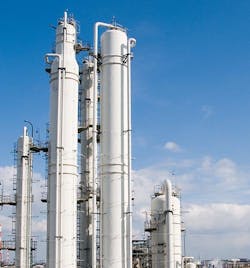Asset Management: AI Stands For “Applications Increase”
Artificial intelligence (AI) and its related digital transformation technologies promise to impact a broad swath of operations and products in the chemical industry. Recent developments by Yokogawa, Seeq and Dow Polyurethanes highlight the diversity and significance of AI to the industry now and in the future.
Yokogawa and Japan’s largest cellular phone company Docomo, both based in Tokyo, have successfully conducted a proof-of-concept (PoC) of remote control technology for industrial processing.
Completed at the end of May, the test involved the use in a cloud environment of an autonomous control AI, the Factorial Kernel Dynamic Policy Programming (FKDPP) algorithm, which was jointly developed by Yokogawa and the Nara Institute of Science and Technology, Ikoma, Japan, and a 5G cellular communications network provided by Docomo.
The FKDPP AI algorithm uses reinforcement learning technology and suits many control applications where either proportional-integral-derivative (PID) control or advanced process control (APC) can’t achieve challenging simultaneous goals such as high quality and energy efficiency.
Yokogawa and Docomo started work on the PoC following an agreement in April 2021. The aim of the demonstration test was to verify whether using FKDPP in the cloud via a 5G network could handle a three-tank level-control system.
A target water level was set and then tests with low- to high-speed control cycles were conducted, and the effects of cellular-communications latency on FKDPP control were investigated.
Compared to 4G, the test demonstrated that, especially with high-speed control, 5G delivers lower latency and less overshoot relative to the target water level, and can handle a control cycle as short as 0.2 sec, thereby achieving better control for more-stable quality and higher energy efficiency.
In effect, the test successfully controlled a simulated plant processing operation, demonstrating that 5G is suitable for the remote control of actual plant processes.
Besides confirming this is the first time the FKDPP algorithm has been used on a 5G network, Keiichiro Kobuchi, vice center head/AI business senior manager, control center, Yokogawa Products, notes the two companies intend to carry out further advanced initiatives aimed at facilitating a shift towards industrial autonomy.
“Both Yokogawa and Docomo will continue to evaluate the use of 5G for remote, autonomous plant operations. By carrying out demonstrations in a wide range of customers’ plants and examining communications reliability and latency-related issues during long-term use, the two companies will strive to achieve 5G and AI-enabled autonomous control,” he adds.
Earlier Field Trial
The Docomo project builds on a field test in a chemical plant carried out in February. Here, FKDPP was used successfully for 35 days to deal with the complex conditions needed to ensure product quality and maintain liquids in a distillation column at an appropriate level while making maximum possible use of waste heat as a heat source (Figure 1).
Figure 1. Test at distillation unit was the first in which artificial intelligence directly changed a manipulated variable. Source: Yokogawa.
The test took place at an ENEOS Materials Corp. chemical plant in Japan and was aimed at controlling processes known to be difficult to automate using existing PID and APC technologies and which, therefore, had been performed manually. (Editor’s note: More details on this application will appear in a forthcoming “Making It Work” article in Chemical Processing.)
In particular, the project wanted to tackle the many situations where veteran operators must step in to halt automated change and configuration values when, for example, atmospheric temperature suddenly shifts due to rainfall or some other weather event.
Yokogawa cites this common issue as a longstanding hurdle when trying to institute autonomous control in situations that currently must rely on manual intervention. The hope is that the collaboration with ENEOS has opened a route to resolving it.
According to Kobuchi, this project is a world first on two counts: one, because AI hasn’t been used to directly change the manipulated variable in a chemical plant before; and, two, because the process ran for 35 days.
“We believe that it will be a disruptive innovation that will automate processes known to be difficult to automate using existing PID and APC control technologies and which, therefore, had been performed manually. FKDPP automates areas that cannot be automated with existing technology. It’s a technology that expands automation,” he says, adding the challenge now is getting customers to fully understand the value FKDPP will offer.
Commercial confidentiality prevents him from revealing the next steps in the Yokogawa/ENEOS project.
However, the project has led to more interest than expected from chemical companies, Kobuchi notes. “Customers are interested in FKDPP not just because it will automate processes known to be difficult to automate… but also because it achieves safe operation and improves productivity, with stable quality, high yield and energy efficiency.”
With safety being a chemical industry priority, clearly demonstrating that new processes and methods ensure safety is as high or higher than with manual operations is essential, he emphasizes. So, the next step is to demonstrate the value and benefits of implementing FKDPP compared to the status quo.
“Quantified results are obviously valuable for this, so the more field tests we can perform across various industries, the easier this will become. It is also important for the customer to have a proactive mindset about implementing DX [digital transformation] initiatives like this. So, Yokogawa welcomes customers who are interested in these initiatives globally.”
In general, the tangible benefits include improved productivity and contributing to a more-sustainable society.
“By linking information on production, inventory, demand and other matters with cloud-based autonomous control AI, it will be possible to align management directives with the actual control of operations on the plant floor. We are looking forward to making more breakthroughs with FKDPP in the near future,” adds Kobuchi.
Meanwhile, the company is promoting the concept of IA2IA – Industrial Automation to Industrial Autonomy — to its global customer base. The idea here is to achieve strong and flexible production that takes into consideration the impact of differences in humans, machines, materials and methods.
“IA2IA refers to the transition to industrial autonomy, and at Yokogawa we are working on roadmaps and solution portfolios that will enable customers to work toward that goal. There is certainly strong interest in the concept,” he says.
Turning to standards, Kobuchi believes industrial autonomy is too broad to have a single one. “But work is already taking place on standards for some enablers, and this is especially necessary in areas like data analysis and AI. This is an evolution from the standards work done for industrial automation over the last several decades, so the ISA-95 standard that has served as a framework for many years will need to evolve, too,” he concludes.
Different Priorities
Other companies see the potential of AI in other contexts. Seeq, Seattle, for example, is focused very much on cloud-based advanced analytics technologies.
“Currently, we don’t see autonomous plant control as an important driver for our chemical customers” says Ashwin Venkat, senior principal scientist for advanced analytics/machine learning (ML).
“Given the complexity of most chemical processing plants and the constantly varying nature of process feeds, energy sources and weather effects, successful autonomous control remains a significant challenge. In our experience, PID and APC control technologies still require frequent human oversight and detailed process understanding to be successful,” he notes.
Rather, Seeq’s customers are focused on using AI and ML technologies for monitoring and diagnostics such as anticipating equipment anomalies and failures, optimizing production, detecting precursors for process quality deviations, and providing real-time monitoring and diagnostics of batch operations.
“Customers are also often interested in scaling these types of AI applications across similar assets,” Venkat adds.
To this end, the company is partnering with industrial automation and digital transformation company NECI, Mansfield, Mass., to help customers harness diagnostic and predictive analytics in a way that will improve their operational efficiencies and provide deeper insights across entire organizations.
“We find the most successful chemical plant monitoring and diagnostic programs are driven by subject matter expertise in combination with fully featured, extensible AI/ML and analytics software for industrial time series data,” he explains.
Typical concerns for less-experienced chemical customers include: how to utilize subject matter expertise to build application/domain-specific models; how to reliably apply the technology in a plant — i.e., demonstrate it is not a black box; how users can collaborate and communicate insights to stakeholders; how the technology fits into existing workflows; and how it has created value for others using, for example, case studies.
Real-Time Foam Formation
Dow Polyurethanes, Horgen, Switzerland, is harnessing the power of AI to cut by a third the development time for new products for its customers (Figure 2).
Figure 2. Virtual laboratory cut foam formulation times by 30%. Source: Dow Polyurethanes.
In March, its efforts won the 2022 Artificial Intelligence Excellence Award from the Business Intelligence Group, Beverly, N.J., for its flagship Predictive Intelligence (PI) digitalization initiative. This annual award recognizes the application of AI to solve real-world problems.
PI combines Dow’s material science expertise with AI and ML capabilities in a virtual laboratory to allow real-time prediction of polyurethane foam formulation properties. PI also can recommend formulations based on desired properties directly inputted by customers.
The company officially launched PI in July 2021 but had been working on computational models, AI, ML and data collection for several years beforehand.
“Predictive Intelligence is a cloud computing capability that accesses global formulations, properties, computational models and process conditions. The data is used to power AI/ML models to predict the properties of new formulations, accelerate product innovation and support faster business decision-making,” explains Clint Schmidt, global Predictive Intelligence leader.
Chemical innovation typically involves running experiments in physical labs that pose personnel, equipment, and scale constraints, he points out. Even the most-advanced, high-throughput labs have limits; so, typical innovation cycles for formulated products range from six months to several years depending on the complexity involved.
“Polyurethane product development specifically involves running several statistical design-of-experiments (DoEs). Collecting the data from different DoEs to predict properties from hundreds of components is challenging and time-consuming. However, AI/ML can ingest data from hundreds of DoEs to reduce the number of experiments required to develop a new product,” says Schmidt.
To achieve this, the company combined expertise, including domain knowledge and the knowhow of data engineers, data scientists, data analysts and cloud computing architects, to create the virtual lab for the company’s global polyurethane formulation efforts. The design of the interfaces with the AI models reflects feedback from users currently piloting the system, enhancing ease of use.
“Our virtual lab can reduce the time involved in traditional formulation development work by up a third, allowing our development scientists to explore new applications,” he stresses.
Overall, PI has made Dow appreciate both the value of its formulations and its domain expertise more than ever. In fact, data from new formulations, such as their properties and manufacturing process conditions, are used to retrain existing models, making them more versatile.
“The intent is eventually to evolve the formulation library into a complete business intelligence platform that can predict customer requirements and develop more cost-effective and environmentally friendly polyurethane products. It will be an accelerator in the space,” believes Schmidt.
Based on Dow’s PI experience so far, Schmidt urges process engineers not to underestimate the value of their own data and domain expertise. With these as a foundation and using expert help to create a virtual lab, it can become a highly valued and regularly used asset for product development scientists.
“Data empowers us to make the right decisions and no longer rely on trial and error or hunches. Everything we need to know to chart the path ahead is now at our fingertips to help us create a better future,” he concludes.
For now, trials continue with selected but unnamed customers. The hope is to make PI available to all polyurethane customers later in 2022.
Seán Ottewell is Chemical Processing's editor at large. You can email him at [email protected]





